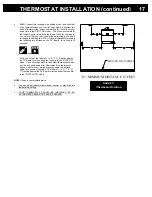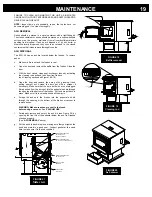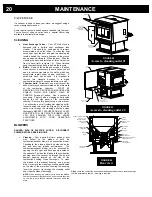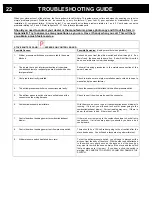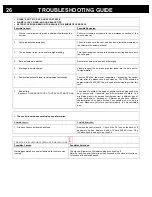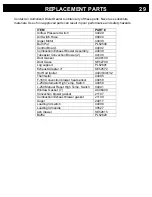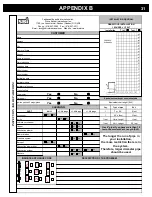
VACCUM USE
If a vacuum is used to clean your stove, we suggest using a
vacuum designed for ashes.
Some regular vacuums and shop vacs leak ash into the room.
Your vacuum or shop vac may have a special filter or bag
available to eliminate this leakage.
CLEANING
a.
Heat Exchange Tubes
– Your ECO-45 stove is
designed with a build-in heat exchanger tube
cleaner. This should be used weekly to remove
accumulated ash on the tubes. To clean the heat
exchanger, open the door and grab the cleaning rod
located behind the louvers (just above the stove’s
door) and push it forward. Close the door. Slide the
cleaning rod back and forth two or three times from
front to back (refer to figure 19). When finished,
push the cleaning rod back in, behind the louvers.
b.
Baffle
: Remove the baffle and scrape off ashes.
Use a vaccum is necessary. In some cases, you will
need to remove creosote on the baffle, which can
accumulate rapidly under certain conditions. A
small wire brush can be used. It is important to
remove this creosote because it is highly
combustible and could cause premature corrosion.
c.
Chamber walls:
Periodically, you must vacuum the
ashes that may have accumulated on the main walls
of the combustion chamber. START BY
REMOVING THE DECORATIVE MASONRY-LIKE
PANELS, WHICH ARE SIMPLY HELD BY
SCREWS. Scrape off ashes. Use a vacuum is
necessary. There is also a cleaning outlet located
behind the left side panel of the combustion
chamber. Remove this panel using a screw driver.
You will notice a small rectangular cleaning outlet.
Inspect behind this outlet (see figure 22) Insert the
vacuum tip through the cleaning outlet and clean
thoroughly. REPEAT THIS OPERATION AT LEAST
ONCE PER TON OF PELLETS BURNED UNTIL
YOU ARE FAMILIAR WITH HOW ASHES
ACCUMULATE WITH YOUR OPERATING
PRACTICES.
BLOWERS
DANGER: RISK OF ELECTRIC SHOCK. DISCONNECT
POWER BEFORE SERVICING UNIT.
Cleaning –
Over a period of time, ashes or dust
may collect on the blades of both the
combustion/exhaust blower and convection blower.
Periodically, the blowers should be cleaned as the
ash and dust can impede performance. The
combustion/exhaust blower can be accessed by
opening the left, right, and back panels located on
the pedestal. To clean the blades in the combustion
housing, insert the vacuum tip through the air inlet
damper opening located on the side of the
combustion housing. Clean thoroughly. To clean
the blades in the exhaust housing, use a screw
driver to remove the cleaning access panel located
on the side of the metal box covering the housing.
Insert the vacuum tip through the cleaning outlet
and clean the blades thoroughly.
NOTE:
When cleaning, be careful not to bend fan blades.
Some stove owners lightly spray an anti-creosote chemical
on the fire to help reduce creosote formation within the
stove.
ACCESS TO
CLEANING
OUTLET
BAFFLE
LEFT SIDE
PANEL OF
COMBUSTION
CHAMBER
ACCESS PANEL
TO EXHAUST BLOWER
ACCESS PANEL
GASKET
BOTTOM LEFT
SIDE PANEL
SIDE
DOOR
PRESSURE
SWITCH
AUGER
MOTOR
CLEANING
ACCESS PANEL
EXHAUST
POWER
CORD
THERMOSTAT
TERMINAL
HIGHT TEMPERATURE
SWITCH L-250
MANUAL RESET
COMBUSTION/EXHAUST
BLOWER MOTOR
IGNITER
CONVECTION
BLOWER
AIR SUPPLY
CONTROL
BLOWER
CONVECTION
THERMISTOR
Oiling –
both the convection and combustion/exhaust blowers have sleeve bearings
that are permanently sealed. No oiling is required.
MAINTENANCE
20
FIGURE 22
Access to cleaning outlet #1
FIGURE 23
Access to cleaning outlet #2
FIGURE 24
Rear view












